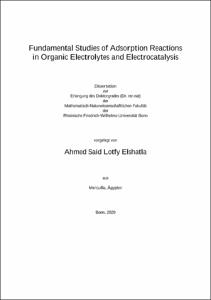Fundamental Studies of Adsorption Reactions in Organic Electrolytes and Electrocatalysis

Fundamental Studies of Adsorption Reactions in Organic Electrolytes and Electrocatalysis

| dc.contributor.advisor | Baltruschat, Helmut | |
| dc.contributor.author | Elshatla, Ahmed Said Lotfy | |
| dc.date.accessioned | 2021-03-18T09:03:11Z | |
| dc.date.available | 2021-03-18T09:03:11Z | |
| dc.date.issued | 18.03.2021 | |
| dc.identifier.uri | https://hdl.handle.net/20.500.11811/8991 | |
| dc.description.abstract | Adsorption processes have a vital influence on the features of heterogeneous electrochemical systems, like processes in electric double-layer capacitors and fuel cell systems. In order to study the fundamentals of such processes, the adsorption of iodide and bromide on Au(111) in aqueous and aprotic solvents has been investigated by cyclic voltammetry, AC-voltammetry, and electrochemical impedance spectroscopy. These techniques showed that the rate of adsorption of iodide is directly proportional to iodide concentration in propylene carbonate, where a complete layer of iodide is formed as in aqueous solution. The adsorption rate of iodide increases when the radii of solvated cations decreases, i.e. in this order: K+ > Na+ > Li+ > TBA+. The rate of adsorption of iodide and bromide on Au(111) and the point of zero charge of Au(111) and roughened Au(111) electrode is dependent on the type of aprotic solvent and water content. The decrease of the iodide adsorption rate in the order DMSO < DG < PC < H2O. This order is related to the decreasing donor number of solvent in the order PC < DG < DMSO except for water. The extent of anion adsorption and thus the maximum coverage on Au(111) electrode decreases in the series of halides I- > Br- due to better solvation and in the solvent order PC < DG < DMSO. XPS measurements confirmed the results obtained from CV that iodide adsorption on Au(111) electrode in PC is stronger than in DMSO in terms of amounts of adsorbed iodide. The crystallographic structure of the electrode surface affects the pzc. Whereas anion adsorption shifts the pzc to a more negative potential, cation identity does not influence the pzc. That the adsorption of PC is enhanced on going to positive potential in presence of iodide has been investigated via ATR-SEIRAS measurements.
Oxidation of adsorbed CO molecules during Formic acid electrocatalysis is improved through bimetallic catalysts of Pt and Pd supported on conducting polymer of poly 1,5 DAN in comparison to the monometallic catalyst, as examined by using DEMS. It was found that Pt/Pd/p1,5–DAN exhibited greater current efficiency than Pd/Pt/p 1,5DAN/GC and monometallic catalysts. In addition, the kind of catalyst support (conducting polymers) plays an essential role in terms of electric conductivity and increased electroactive surface area of the catalyst for the enhancement of electrocatalysis of ethylene glycol on the binary catalyst of Pt and Pd. Using DEMS, it was found that Pt/Pd/p1,8-DAN showed higher current efficiency than Pt/Pd/p1,5-DAN and Pt/Pd/p1,2-DAAQ. | en |
| dc.language.iso | eng | |
| dc.rights | In Copyright | |
| dc.rights.uri | http://rightsstatements.org/vocab/InC/1.0/ | |
| dc.subject.ddc | 540 Chemie | |
| dc.title | Fundamental Studies of Adsorption Reactions in Organic Electrolytes and Electrocatalysis | |
| dc.type | Dissertation oder Habilitation | |
| dc.publisher.name | Universitäts- und Landesbibliothek Bonn | |
| dc.publisher.location | Bonn | |
| dc.rights.accessRights | openAccess | |
| dc.identifier.urn | https://nbn-resolving.org/urn:nbn:de:hbz:5-61035 | |
| ulbbn.pubtype | Erstveröffentlichung | |
| ulbbnediss.affiliation.name | Rheinische Friedrich-Wilhelms-Universität Bonn | |
| ulbbnediss.affiliation.location | Bonn | |
| ulbbnediss.thesis.level | Dissertation | |
| ulbbnediss.dissID | 6103 | |
| ulbbnediss.date.accepted | 21.12.2020 | |
| ulbbnediss.institute | Mathematisch-Naturwissenschaftliche Fakultät : Fachgruppe Chemie / Institut für Physikalische und Theoretische Chemie | |
| ulbbnediss.fakultaet | Mathematisch-Naturwissenschaftliche Fakultät | |
| dc.contributor.coReferee | Bredow, Thomas |
Dateien zu dieser Ressource
Das Dokument erscheint in:
-
E-Dissertationen (4311)




